-
ARTÍCULO ORIGINAL08/12/2024
Initial nipple damages in breastfeeding women: analysis of photographic images and clinical associations
Revista Brasileira de Enfermagem. 2024;77(1):e20220773
Resumen
ARTÍCULO ORIGINALInitial nipple damages in breastfeeding women: analysis of photographic images and clinical associations
Revista Brasileira de Enfermagem. 2024;77(1):e20220773
DOI 10.1590/0034-7167-2022-0773
Visualizações0Ver maisABSTRACT
Objective:
to analyze the initial nipple damage degree by breastfeeding practice and to associate findings with clinical manifestations of breastfeeding women.
Methods:
a retrospective, cross-sectional study with primary data and photographic images database from two randomized clinical trials. Photographic images were analyzed by two independent evaluators using the Nipple Trauma Score. For analysis, the chi-square, Mann-Whitney tests and Kappa coefficient were applied.
Results:
115 breastfeeding women and their respective 186 photographic images were analyzed. The degree of agreement of evaluators using the Nipple Trauma Score was 93.6%. The nipple pain score during breastfeeding was moderate and compromised more than 25% of the nipple surface area.
Conclusions:
assistance to breastfeeding women should prioritize nipple pain intensity instead of the nipple damage size.
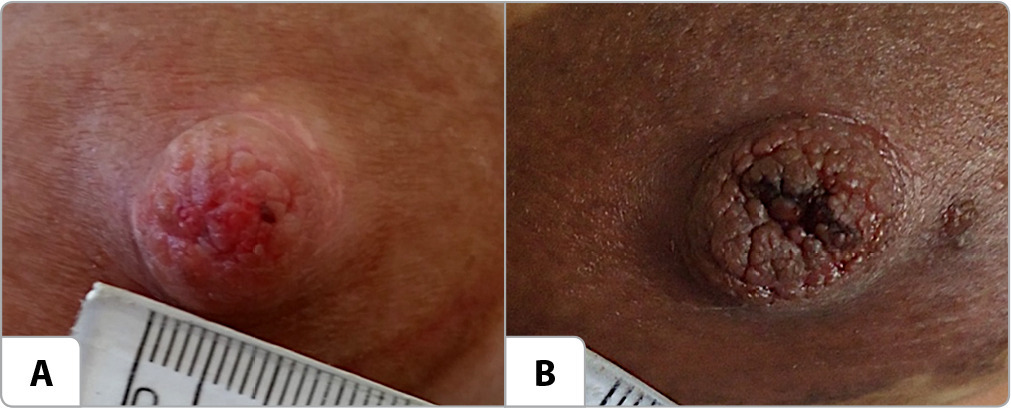
-
ARTÍCULO ORIGINAL08/12/2024
Safe practices for bed bathing in the intensive care unit: validation of a checklist
Revista Brasileira de Enfermagem. 2024;77(1):e20230135
Resumen
ARTÍCULO ORIGINALSafe practices for bed bathing in the intensive care unit: validation of a checklist
Revista Brasileira de Enfermagem. 2024;77(1):e20230135
DOI 10.1590/0034-7167-2023-0135
Visualizações0Ver maisABSTRACT
Objective:
To validate a checklist for safe bathing in critically ill patients.
Methods:
This is a methodological and quantitative study. Researchers developed a checklist for safe bathing in critically ill patients consisting of 41 items, which were submitted to the apparent and content validation process, evaluated by eleven judges, and interobserver reliability. For reliability analysis, the instrument was applied in 54 bed bath procedures in the ICU; Kappa and CHF tests were used.
Results:
In the apparent and content validation, adjustments were made according to the judges’ suggestions. Kappa values ranged from moderate to almost perfect (0.462 to 0.962), and, in some items, there was 100% agreement; the reliability of the instrument was excellent (ICC = 0.962).
Conclusion:
The instrument proved to be dependable and easy to apply. Its use will contribute to safe bed bathing and subsidize interventions aimed at increasing the quality of care.
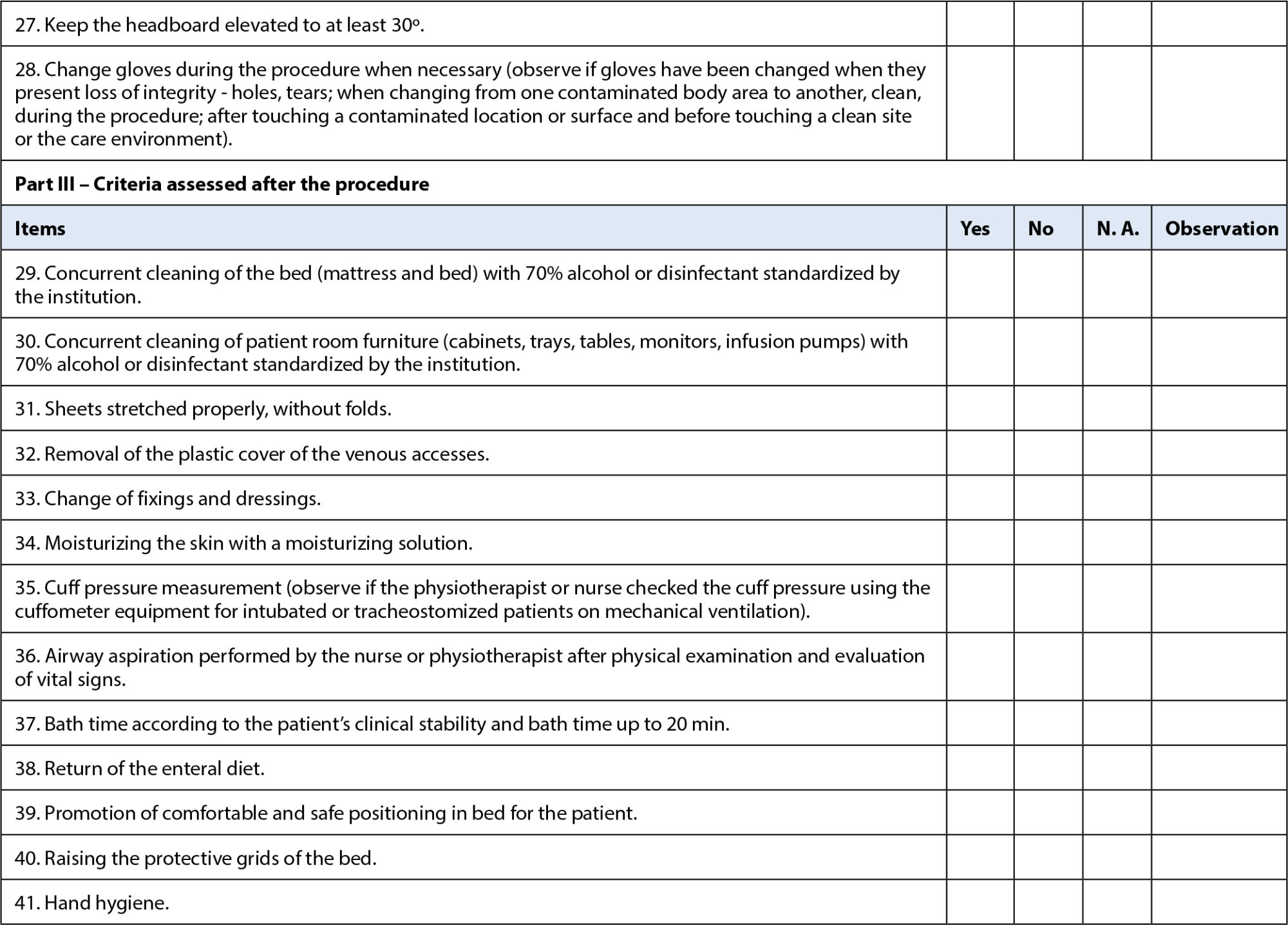
-
ARTÍCULO DE REVISIÓN29/11/2024
Assessment of knowledge in oncology about care for transgender people: a scoping review
Revista Brasileira de Enfermagem. 2024;77:e20230532
Resumen
ARTÍCULO DE REVISIÓNAssessment of knowledge in oncology about care for transgender people: a scoping review
Revista Brasileira de Enfermagem. 2024;77:e20230532
DOI 10.1590/0034-7167-2023-0532
Visualizações0Ver maisABSTRACT
Objective:
to identify evidence available in the literature on instruments and methodologies used to assess healthcare professionals’ knowledge about cancer care for the transgender population.
Methods:
a scoping review was conducted in seven databases, including studies that answered the question: what is the healthcare professionals’ level of knowledge about cancer care for the transgender population?
Results:
forty-one articles were selected that dealt specifically with healthcare professionals’knowledge in relation to care for the LGBTQIAPN+ population, especially the transgender population. Eighteen studies assessed patients’ perceptions of professionals’knowledge, whereas other studies used their own assessment tools, considering the global context of LGBTQIAPN+ health.
Conclusions:
there is no tested and validated instrument that assesses the knowledge about the transgender population’s oncological health, highlighting the need to construct and validate an instrument focused on this population’s needs.
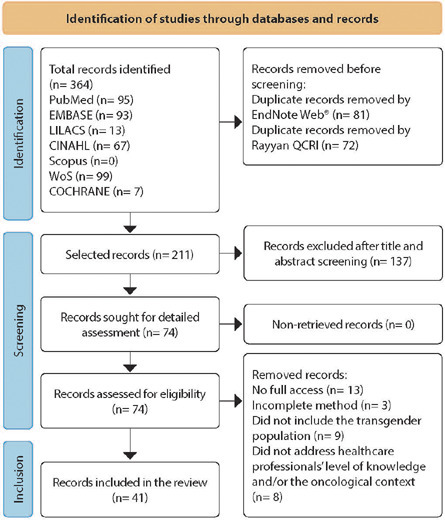
-
ARTÍCULO ORIGINAL29/11/2024
Sleep quality of vulnerable elderly people: associated factors
Revista Brasileira de Enfermagem. 2024;77:e20230283
Resumen
ARTÍCULO ORIGINALSleep quality of vulnerable elderly people: associated factors
Revista Brasileira de Enfermagem. 2024;77:e20230283
DOI 10.1590/0034-7167-2023-0283
Visualizações0Ver maisABSTRACT
Objective:
To identify factors associated with poor sleep quality in elderly dependent individuals in social vulnerability.
Method:
Cross-sectional study with 59 elderly dependent individuals assisted by Family Health Units in São Carlos/SP. The following tools were used: Katz Index, Lawton and Brody Scale, Pittsburgh Sleep Quality Index, Addenbrooke’s Cognitive Examination Revised, Fried’s Frailty Phenotype, Geriatric Depression Scale (15 items), Perceived Stress Scale, Family APGAR, Social Support Scale from the Medical Outcomes Study, and World Health Organization Quality of Life, abbreviated and “old” versions.
Results:
The majority of participants were women (52.5%), aged 60-74 years (71.1%), and had poor sleep quality (76.2%). Stress (OR=1.12; 95%CI=1.02-1.22) and polypharmacy (OR=7.39; 95%CI=1.22-44.73) increased the chances of poor sleep quality, while physical activity decreased these chances (OR=0.15; 95%CI=0.02-0.79).
Conclusion:
Stress and polypharmacy are associated with poor sleep quality in elderly dependent individuals.
-
ARTÍCULO DE REVISIÓN22/11/2024
Transition to family parenting in the face of the first child: a scoping review
Revista Brasileira de Enfermagem. 2024;77(5):e20230487
Resumen
ARTÍCULO DE REVISIÓNTransition to family parenting in the face of the first child: a scoping review
Revista Brasileira de Enfermagem. 2024;77(5):e20230487
DOI 10.1590/0034-7167-2023-0487
Visualizações1Ver maisABSTRACT
Objectives:
to identify and summarize the elements that characterize the family transition process in relation to the first child.
Methods:
a scoping review was carried out based on JBI methodology, in six databases, following the Preferred Reporting Items for Systematic reviews and Meta-Analyses extension for Scoping Reviews checklist.
Results:
ten articles were included with factors characterizing the transition, such as hindering/facilitating conditions that influence the process, important support structures in adaptation and strategies/responses used in the transition process.
Final Considerations:
elements characterizing the transition process in relation to the first child were identified. However, no theoretical explanation for this was identified. Further research should be carried out to obtain a deeper understanding of this process.
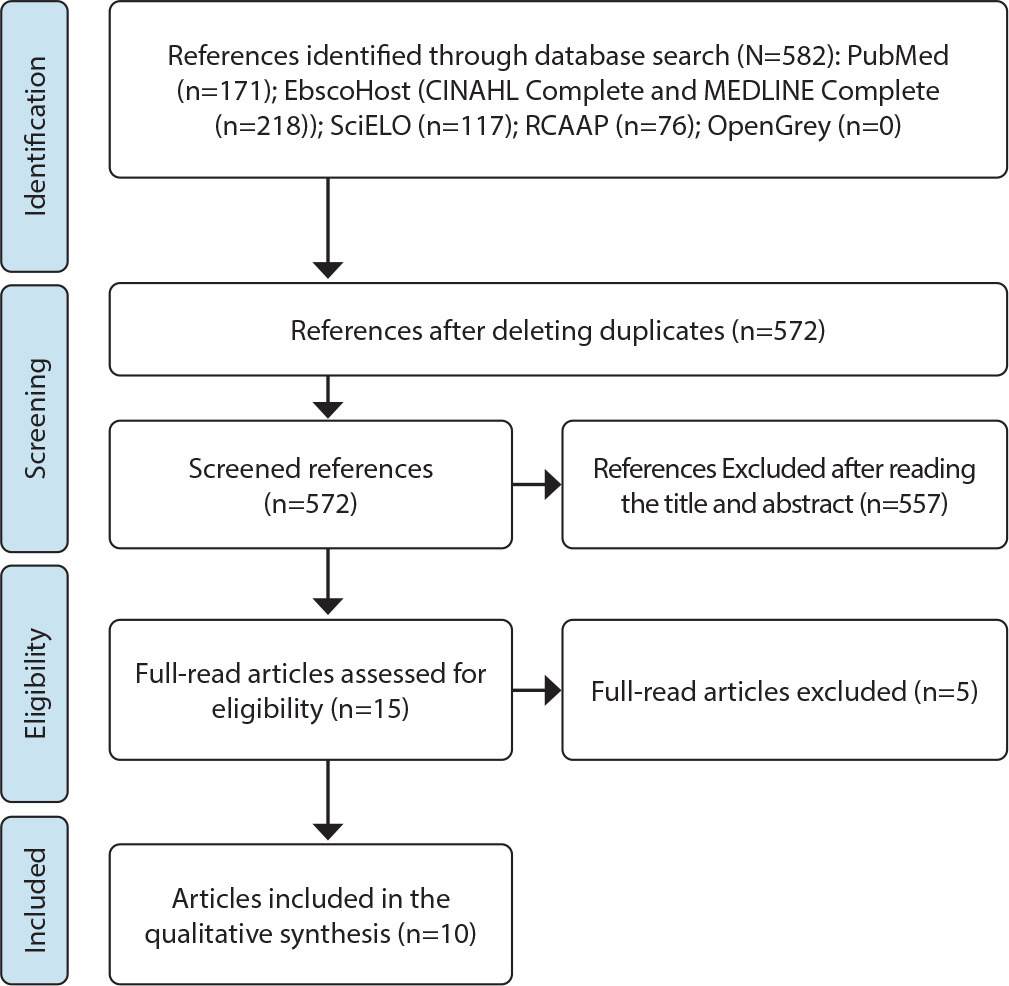
-
22/11/2024
Social Technology in the Prevention of Adolescent Violence: documentary production
Revista Brasileira de Enfermagem. 2024;77(5):e20230298
Resumen
Social Technology in the Prevention of Adolescent Violence: documentary production
Revista Brasileira de Enfermagem. 2024;77(5):e20230298
DOI 10.1590/0034-7167-2023-0298
Visualizações0Ver maisABSTRACT
Objective:
To report the development of a technological innovation in the form of a documentary, aimed at disseminating actions for preventing violence against adolescents within the context of Primary Health Care.
Methods:
The documentary was developed through action research and interventions with adolescents in the territory of a Health Unit, conducted between 2020 and 2022, using Social Technology as both an action strategy and a conceptual reference.
Results:
The Social Technology proposal, created through workshops and seminars, resulted in a documentary focusing on violence prevention, involving 48 adolescents. The documentary’s script, collectively developed, portrays a soccer match between teams symbolizing peace and violence, with peace ultimately prevailing. The documentary is six minutes long.
Final Considerations:
The documentary has proven to be an effective Social Technology tool among adolescents, as it fosters critical thinking, is accessible, has potential for digital dissemination, and appeals to the target audience.
-
ARTÍCULO ORIGINAL22/11/2024
Prevalence of prescription and effectiveness of analgesia for treating vaginal delivery pain
Revista Brasileira de Enfermagem. 2024;77(5):e20230327
Resumen
ARTÍCULO ORIGINALPrevalence of prescription and effectiveness of analgesia for treating vaginal delivery pain
Revista Brasileira de Enfermagem. 2024;77(5):e20230327
DOI 10.1590/0034-7167-2023-0327
Visualizações0Ver maisABSTRACT
Objectives:
to assess pain management during labor.
Methods:
a cross-sectional study was carried out by reviewing medical records and conducting postpartum interviews. Prevalence and effectiveness of analgesia were assessed.
Results:
the prevalence of non-pharmacological analgesia was 61.86% of 215 women in labor in Obstetric Center and 82.51% of 62 in midwife-led unit. Prevalence of severe pain, on the Visual Analogue Scale, before and after non-pharmacological analgesia, was from 92.16% to 64.04% (p=0.00) in Obstetric Center and from 85.96% to 52.63% (p=0.01) in midwife-led unit. Prevalence of pharmacological analgesia in Obstetric Centers was 15.81%, with no variation in severe pain (p=0.57). Patients’ request for analgesia was associated with education (p=0.00) and pain intensity (p=0.02).
Conclusions:
non-pharmacological analgesia improved pain intensity. Prevalence of pharmacological analgesic prescription was lower than that identified in developed countries. Pain management needs to consider the preferences and needs of women in labor.
-
INFORME DE EXPERIENCIA01/01/2018
Clinical and epidemiological teaching of dengue through simulated practice
Revista Brasileira de Enfermagem. 2018;71(2):451-456
Resumen
INFORME DE EXPERIENCIAClinical and epidemiological teaching of dengue through simulated practice
Revista Brasileira de Enfermagem. 2018;71(2):451-456
DOI 10.1590/0034-7167-2016-0503
Visualizações2Ver maisABSTRACT
Objective:
to describe the experience of clinical teaching on dengue and the practice of epidemiological surveillance using problematization methodology.
Method:
report of experience on educational activity with undergraduate nursing students, held in March 2016, at a public university in the city of São Paulo, conceived in four stages: dialogic lecture, active search of Aedes aegypti, case study and simulation of nursing consultation to individuals with dengue.
Results:
The activity allowed to retrieve previous knowledge about the disease, respond to exercises that addressed different clinical situations and epidemiological surveillance, including in situ evaluation of possible mosquito outbreaks, and discuss the need to expand prevention and health of the individual and the community, the impact of the media in the dissemination of cases and the coping difficulties experienced in the different levels of attention.
Conclusion:
the methodology adopted enabled qualified training of students to cope with dengue.

-
ARTÍCULO ORIGINAL18/07/2022
Beliefs, knowledge, actions of nursing techniques in breastfeeding in pain management in immunization
Revista Brasileira de Enfermagem. 2022;75(6):e20210546
Resumen
ARTÍCULO ORIGINALBeliefs, knowledge, actions of nursing techniques in breastfeeding in pain management in immunization
Revista Brasileira de Enfermagem. 2022;75(6):e20210546
DOI 10.1590/0034-7167-2021-0546
Visualizações1Ver maisABSTRACT
Objective:
Understand the beliefs, knowledge, and actions of nursing technicians on breastfeeding as a form of non-pharmacological intervention to relieve pain in newborns and infants during immunization.
Methods:
Qualitative study carried out through semi-structured interviews with nine nursing technicians from three Basic Health Units in a city in the state of São Paulo. The theoretical approach of the Belief Model and the methodological framework of Thematic Analysis supported this study.
Results:
Three themes originated: Beliefs, Knowledge, and Actions of nursing technicians.
Final considerations:
Despite knowledge about the benefits of breastfeeding as the most effective method for relieving pain in newborns and infants during vaccination, their restrictive beliefs overrode the evidence, leading them to act in ways that discourage or prevent the mother from breastfeed during vaccination. Formal training is recommended to align with current evidence-based practices.
-
ARTÍCULO DE REVISIÓN08/12/2023
Educational technologies for accident prevention due to falls in childhood: a scoping review
Revista Brasileira de Enfermagem. 2023;76:e20220807
Resumen
ARTÍCULO DE REVISIÓNEducational technologies for accident prevention due to falls in childhood: a scoping review
Revista Brasileira de Enfermagem. 2023;76:e20220807
DOI 10.1590/0034-7167-2022-0807
Visualizações2Ver maisABSTRACT
Objectives:
to map evidence on educational technology use for accident prevention due to falls in childhood.
Methods:
a scoping review, carried out in October and November 2022, in the MEDLINE, Web of Science, BDENF and CINAHL databases and LILACS bibliographic index. There was no delimitation of language or time. Data were extracted and analyzed descriptively by two independent researchers. The research protocol was registered in the Open Science Framework.
Results:
twenty-six studies were selected. Booklets, pamphlets and leaflets were the most used technologies, presenting health services as the most frequent environment to develop research on fall prevention. The technologies developed were important outcomes: increased knowledge of children, family members, caregivers, health and education professionals.
Conclusions:
educational technology use makes it possible to increase knowledge, adopt safe practices and reduce falls.

-
ARTÍCULO DE REVISIÓN15/03/2024
Resources for health literacy among caregivers of prematurely born children: a scoping review
Revista Brasileira de Enfermagem. 2024;77(1):e20230062
Resumen
ARTÍCULO DE REVISIÓNResources for health literacy among caregivers of prematurely born children: a scoping review
Revista Brasileira de Enfermagem. 2024;77(1):e20230062
DOI 10.1590/0034-7167-2023-0062
Visualizações1Ver maisABSTRACT
Objectives:
to map the available evidence on resources used to promote health literacy among caregivers of prematurely born children during outpatient follow-up.
Methods:
the Joanna Briggs Institute’s scope review protocol was utilized. The search encompassed six databases, incorporating studies from 2012 to 2022.
Results:
the three included publications revealed that the resources employed are: mobile applications, phone calls, individual counseling, videos, educational pamphlets, and group discussions. Implementing an education protocol during the transition home enhances scientifically grounded health promotion rates.
Conclusions:
there is limited literature addressing the health literacy of these caregivers. The nursing team plays a crucial role in health education and in developing resources applicable to these families.

-
ARTÍCULO ORIGINAL13/01/2024
Social representations of oncologic surgery for patients with cancer
Revista Brasileira de Enfermagem. 2024;77(6):e20230273
Resumen
ARTÍCULO ORIGINALSocial representations of oncologic surgery for patients with cancer
Revista Brasileira de Enfermagem. 2024;77(6):e20230273
DOI 10.1590/0034-7167-2023-0273
Visualizações2Ver maisABSTRACT
Objectives:
to analyze the social representations of patients with cancer regarding oncologic surgery.
Methods:
a qualitative study based on Social Representation Theory was conducted with 126 participants between October 2021 and May 2022 in a public hospital in Rio de Janeiro. A characterization questionnaire, free evocations of the inducing term “surgery”, and semi-structured interviews with 60 participants were applied. Data were analyzed using Microsoft Excel® and IRaMuTeQ.
Results:
the central core of the representation is composed of fear, cure, hope, and removing the disease. The analysis of interviews resulted in six classes that highlight the social changes caused by treatment as well as the need for a support network to cope with the surgical process.
Final Considerations:
the representations reflect fear and hope towards the procedure and the desire to remove the disease, thus translating the cure through surgery.

-
ARTÍCULO ORIGINAL13/01/2024
Nurses’ perspectives on the use of telemonitoring in the management of people with diabetes and hypertension
Revista Brasileira de Enfermagem. 2024;77(6):e20230481
Resumen
ARTÍCULO ORIGINALNurses’ perspectives on the use of telemonitoring in the management of people with diabetes and hypertension
Revista Brasileira de Enfermagem. 2024;77(6):e20230481
DOI 10.1590/0034-7167-2023-0481
Visualizações3Ver maisABSTRACT
Objectives:
to understand the perspective of nurses on the use of telemonitoring in the management of people with type 2 diabetes mellitus and arterial hypertension in primary care.
Methods:
this qualitative research involved sixteen nurses from eight municipalities in Paraná. Data were collected between November 2022 and January 2023 through inperson or remote interviews, which were audio-recorded and subjected to content analysis.
Results:
according to the nurses, telemonitoring enhances users’ knowledge about these conditions, communication and connection with the team, and productivity. However, the lack of electronic resources and equipment, high staff turnover, low user adherence, and the limited availability of professional time present significant challenges.
Final Considerations:
the effective implementation and operation of telemonitoring in the management of people with diabetes and hypertension involve both potential benefits and barriers. It is essential to have the availability of human and technological resources, managerial support, and the commitment of professionals and users.
-
ERRATUM13/01/2024
ERRATUM
Revista Brasileira de Enfermagem. 2024;77(6):e2024n6e08
Resumen
ERRATUMERRATUM
Revista Brasileira de Enfermagem. 2024;77(6):e2024n6e08
DOI 10.1590/0034-7167.20247706e08
Visualizações2In the article “Brazilian nursing specific situation, middle and micro-range theories: a bibliometric study”, with DOI number: , published in Revista Brasileira de Enfermagem, 2024;77(4):e20230520, Chart 1:Where it read:[…]Ver mais -
ARTÍCULO ORIGINAL29/09/2022
Palliative care production for health professionals in the context of home care
Revista Brasileira de Enfermagem. 2022;75(1):e20210030
Resumen
ARTÍCULO ORIGINALPalliative care production for health professionals in the context of home care
Revista Brasileira de Enfermagem. 2022;75(1):e20210030
DOI 10.1590/0034-7167-2021-0030
Visualizações1Ver maisABSTRACT
Objectives:
to analyze palliative care production developed by health professionals to home care patients.
Methods:
this is an exploratory study, with a qualitative approach, using the transpersonal care theoretical framework. Thirteen interviews were conducted with health professionals and 18 observations were conducted on different cases. Content analysis was performed using MAXQDA©.
Results:
actions performed: maintenance and follow-up measures to people eligible for palliative care, in acts of dialogue and «listening» to caregivers and users, conducting guidelines for the care and self-care process, performing technical procedures, delivery of materials, referrals and medical prescriptions to users.
Final Considerations:
it is perceived the need for advances in the implementation of government policies in Brazil that insert palliative care into the Health Care Network through educational, managerial and care actions that ensure human dignity, thus allowing the development of these and other palliative care interventions.
-
ARTÍCULO ORIGINAL22/04/2020
Coordenação e longitudinalidade da atenção primária à saúde na Amazônia brasileira
Revista Brasileira de Enfermagem. 2020;73(3):e20180841
Resumen
ARTÍCULO ORIGINALCoordenação e longitudinalidade da atenção primária à saúde na Amazônia brasileira
Revista Brasileira de Enfermagem. 2020;73(3):e20180841
DOI 10.1590/0034-7167-2018-0841
Visualizações0RESUMO
Objetivos:
avaliar os atributos da atenção básica, longitudinalidade e coordenação do cuidar, a partir da percepção do profissional e dos pacientes no estado do Amazonas, Brasil.
Métodos:
pesquisa avaliativa quantitativa em que foi utilizado um instrumento de avaliação externa com 469 profissionais e 1.888 pacientes de 367 unidades básicas de saúde, que aderiram ao Programa de Melhoria de Acesso e Qualidade da Atenção Primária à Saúde padronizados pelo Ministério da Saúde do Brasil. Os dados foram agrupados por análise multivariada de cluster para encontrar uma classificação da atenção primária à saúde sob o ponto de vista de profissionais e pacientes.
Resultados:
os atributos de coordenação e longitudinalidade ainda são expressos de forma fraca e pouco desenvolvida no cenário da Amazônia brasileira.
Conclusões:
é necessário reconhecer as barreiras organizacionais e o que pode promover condições para que as equipes de atenção primária à saúde atuem sob a perspectiva de um cuidado contínuo, integral e coordenado.
Palavras-chave: Atenção Primária à SaúdeAvaliação em SaúdeContinuidade da Assistência ao PacienteIntegralidade em SaúdePolítica de SaúdeVer mais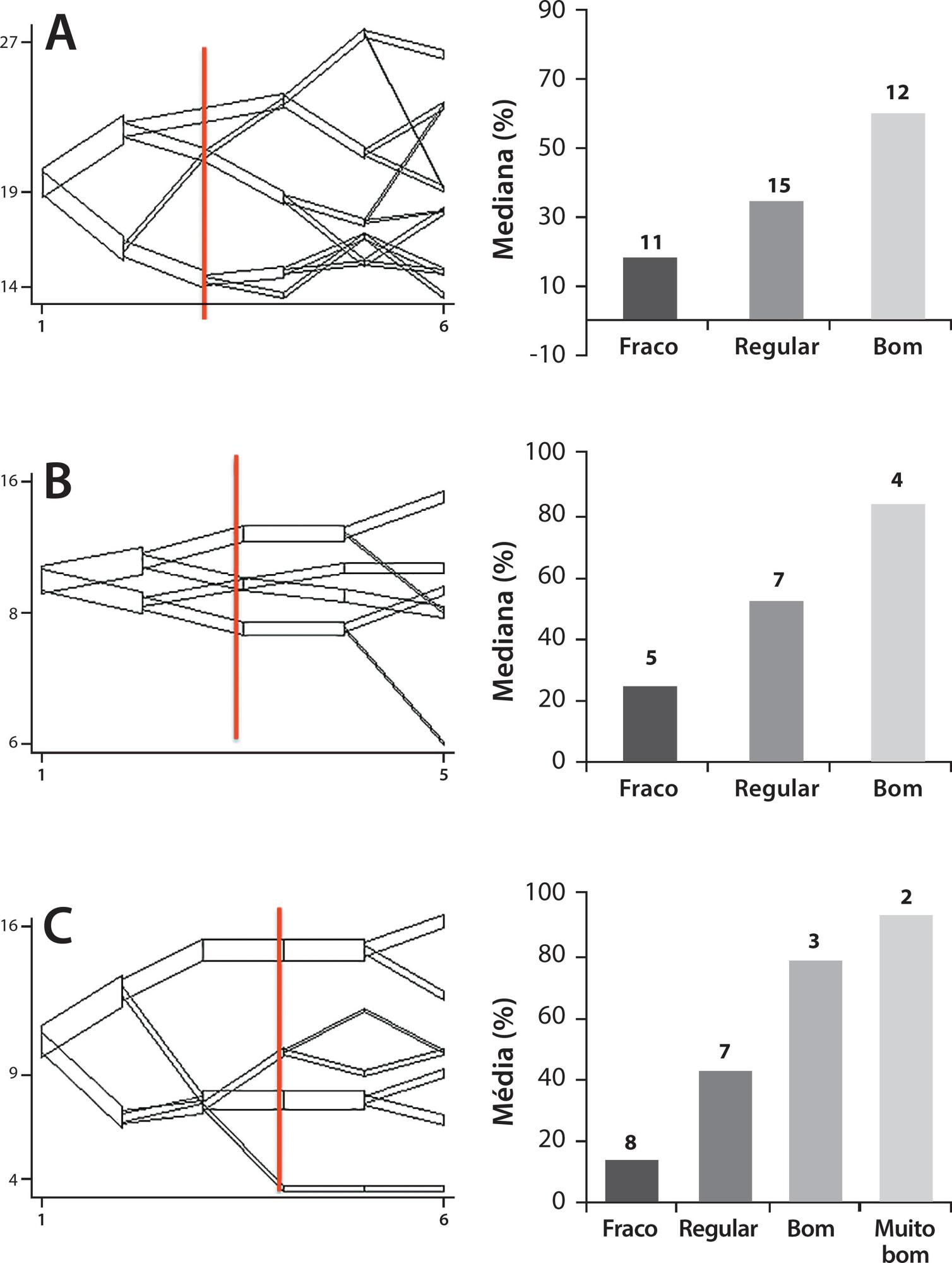
-
ARTÍCULO ORIGINAL03/04/2020
Nursing work in assisted human reproduction: between technology and humanization
Revista Brasileira de Enfermagem. 2020;73(3):e20170919
Resumen
ARTÍCULO ORIGINALNursing work in assisted human reproduction: between technology and humanization
Revista Brasileira de Enfermagem. 2020;73(3):e20170919
DOI 10.1590/0034-7167-2017-0919
Visualizações0Ver maisABSTRACT
Objectives:
To analyze the social representations of nurses who work with assisted human reproduction about the operation with reproductive biotechnologies.
Methods:
Qualitative approach, supported by the Theory of Social Representations, with sixteen participants. Individual, semi-structured interviews, analyzed through the Alceste software.
Results:
Pragmatic elements related to nurses’ performance from a professional, institutional, and public policy perspective in reproductive biotechnologies emerged, demonstrating the practical dimension of these representations. The characteristics of the professional to act in this area were addressed, showing the lack of information and search for scientificity; precarious perception of the organizational structure of health services; and attributions of nursing care arising from the health care practice in assisted human reproduction.
Final considerations:
Social representation is anchored in the link between technology/medicalization and humanization/reception regarding reproductive biotechnologies. Working in assisted human reproduction involves a new and challenging nursing care, requiring specific and ethical knowledge.
-
ARTÍCULO ORIGINAL07/08/2020
Quality of life and spirituality of patients with chronic kidney disease: pre- and post-transplant analysis
Revista Brasileira de Enfermagem. 2020;73:e20190408
Resumen
ARTÍCULO ORIGINALQuality of life and spirituality of patients with chronic kidney disease: pre- and post-transplant analysis
Revista Brasileira de Enfermagem. 2020;73:e20190408
DOI 10.1590/0034-7167-2019-0408
Visualizações0Ver maisABSTRACT
Objective:
to compare the quality of life (QoL) of patients under dialysis and after kidney transplant; correlate the QoL of transplant patients to sociodemographic, morbid and spirituality/religiosity variables.
Method:
prospective study with a quantitative approach, with a sample of 27 patients who underwent peritoneal dialysis or dialysis undergoing kidney transplant. QoL and spirituality were assessed by the KDQOL-SF and WHOQOL-SRPB tools, being correlated with sociodemographic and economic variables.
Results:
the dimensions of total mental component, kidney disease effects and kidney disease burden showed significant improvement in the post-transplant period, with p <0.0004. There was a significant correlation between four dimensions of spirituality and seven dimensions of QoL; p ranged from 0.04 to 0.006.
Conclusion:
there was a significant improvement in QoL in the post-transplant period. The dimensions of spirituality: wholeness and integration, spiritual connection, wonder and inner peace were positively correlated with seven dimensions of QoL.
-
ARTÍCULO DE REVISIÓN22/04/2020
Health advocacy and primary health care: evidence for nursing
Revista Brasileira de Enfermagem. 2020;73(3):e20180987
Resumen
ARTÍCULO DE REVISIÓNHealth advocacy and primary health care: evidence for nursing
Revista Brasileira de Enfermagem. 2020;73(3):e20180987
DOI 10.1590/0034-7167-2018-0987
Visualizações0Ver maisABSTRACT
Objectives:
to analyze nursing actions involving health advocacy in the context of primary health care and the consolidation of this right to health.
Methods:
this is an integrative literature review with content analysis of the results on health advocacy and its relationship with nursing in the context of primary health care.
Results:
the content analysis of the seven selected studies resulted in two thematic categories: “Right to health – a complex and progressive consolidation movement in Brazil” and “Advocacy in health and nursing”.
Conclusions:
despite the difficulties in defining the concept of health advocacy, nurses, in their practice, act with innovative alternatives to daily conflicts, exercising the users’ right to health in their relationships with health team members and the community.

-
ARTÍCULO ORIGINAL02/02/2022
The Healthcare Failure Mode and Effect Analysis as a tool to evaluate care protocols
Revista Brasileira de Enfermagem. 2022;75(3):e20210153
Resumen
ARTÍCULO ORIGINALThe Healthcare Failure Mode and Effect Analysis as a tool to evaluate care protocols
Revista Brasileira de Enfermagem. 2022;75(3):e20210153
DOI 10.1590/0034-7167-2021-0153
Visualizações0Ver maisABSTRACT
Objectives:
to identify, classify, and analyze modes of failure in the medication process.
Methods:
evaluative research that used the Healthcare Failure Mode and Effect Analysis (HFMEA) in a service of bone marrow transplant from June to September 2018, with the participation of 35 health workers.
Results:
207 modes of failure were identified and classified as mistakes in verification (14%), scheduling (25.6%), administration (29%), dilution (16.4%), prescription (2.4%), and identification (12.6%). The analysis of risk showed a moderate (51.7%) and high (30.9%) need of intervention, leading to the creation of an internal quality assurance group and of continued education activities.
Conclusions:
the Healthcare Failure Mode and Effect Analysis showed itself to be a tool to actively identify, classify, and analyze failures in the process of medication, contributing for the proposal of actions aimed at patient safety.

-
ARTÍCULO ORIGINAL09/03/2020
Actions of nurses toward obesity in primary health care units
Revista Brasileira de Enfermagem. 2020;73(2):e20180404
Resumen
ARTÍCULO ORIGINALActions of nurses toward obesity in primary health care units
Revista Brasileira de Enfermagem. 2020;73(2):e20180404
DOI 10.1590/0034-7167-2018-0404
Visualizações0Ver maisABSTRACT
Objectives:
To understand the actions of nurses toward obesity in primary health care units.
Methods:
A phenomenological study was carried out with 12 nurses of a city in the state of Minas Gerais. The interviews were organized into categories and analyzed according to the social phenomenology of Alfred Schütz and literature associated with the theme.
Results:
The following categories emerged, expressing the actions of nurses toward obesity prevention and control: “Guidance on healthy lifestyle habits”, “Barriers to the actions of nurses”, and “Focusing specifically on obesity”.
Final considerations:
Considering that guidance on healthy lifestyle habits was mostly carried out during individual and collective activities directed to the general population, regardless of their weight conditions, nurses must reorganize their professional practice in primary health care units by implementing specific actions for users with obesity or at risk of developing it.
-
ARTÍCULO ORIGINAL17/02/2020
Predictive model of hospitalization for children and adolescents with chronic disease
Revista Brasileira de Enfermagem. 2020;73(2):e20180467
Resumen
ARTÍCULO ORIGINALPredictive model of hospitalization for children and adolescents with chronic disease
Revista Brasileira de Enfermagem. 2020;73(2):e20180467
DOI 10.1590/0034-7167-2018-0467
Visualizações0Ver maisABSTRACT
Objectives:
Describe a predictive model of hospitalization frequency for children and adolescents with chronic disease.
Methods:
A decision tree-based model was built using a database of 141 children and adolescents with chronic disease admitted to a federal public hospital; 18 variables were included and the frequency of hospitalization was defined as the outcome.
Results:
The decision tree obtained in this study could properly classify 80.85% of the participants. Model reading provided an understanding that situations of greater vulnerability such as unemployment, low income, and limited or lack of family involvement in care were predictors of a higher frequency of hospitalization.
Conclusions:
The model suggests that nursing professionals should adopt prevention actions for modifiable factors and authorities should make investments in health promotion for non-modifiable factors. It also enhances the debate about differentiated care to these patients.

-
ARTÍCULO ORIGINAL29/11/2022
Ethics in nursing: categorization of legal processes
Revista Brasileira de Enfermagem. 2022;75(3):e20210099
Resumen
ARTÍCULO ORIGINALEthics in nursing: categorization of legal processes
Revista Brasileira de Enfermagem. 2022;75(3):e20210099
DOI 10.1590/0034-7167-2021-0099
Visualizações0Ver maisABSTRACT
Objectives:
to categorize factual elements of ethical-disciplinary nursing lawsuits in the state of Goiás.
Methods:
cross-sectional, retrospective study, based on secondary data obtained from ethical-disciplinary lawsuits filed at the Regional Nursing Council of Goiás (Coren-Goiás) between the years 2010 and 2019.
Results:
the highest number of lawsuits filed was in 2013 and 2014, with a greater frequency in the state capital. The majority came from the Nursing Ethics Committees and ex-officio complaints. The professional with most complaints was the nursing technician, aged between 31 and 40 years old, at the beginning of their career. The most common type of complaints referred to performing attributions that were not within the nursing competences.
Conclusions:
as a highlight are the contributions of this study to professional ethics in nursing and the clear need to consolidate these skills in nurses who are in training and in the continuous education for those already in the profession.
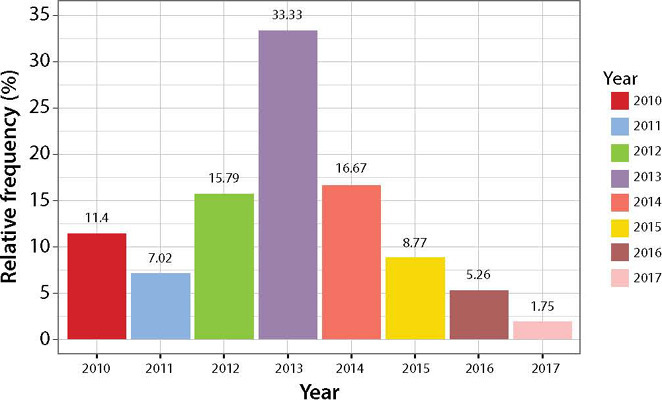
Búsqueda
Buscar en:
Nuvem de Tags
Adolescente (85) Atenção Primária à Saúde (239) COVID-19 (91) Criança (91) Cuidados de Enfermagem (269) Educação em Enfermagem (151) Educação em Saúde (139) Enfermagem (930) Enfermagem Pediátrica (86) Estudantes de Enfermagem (77) Estudos de Validação (131) Família (87) Idoso (208) Promoção da Saúde (99) Qualidade de Vida (104) Saúde do Trabalhador (86) Saúde Mental (145) Saúde Pública (82) Segurança do Paciente (150) Tecnologia Educacional (100)



